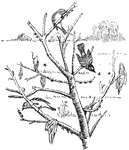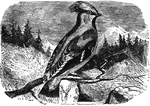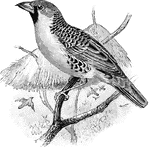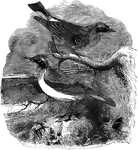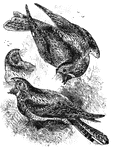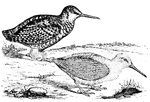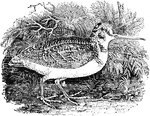186 illustrations of birds including: wagtail, warbler, waxwing, weaver-bird, wheat-ear, whinchat, whippoorwill, widgeon, widow-bird, woodcock, woodlark, woodpecker, woodsnipe, wren, wrentits, wryneck, and yellow-throat
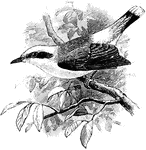
Water Tyrant
Fluvicola climacura is a watercap or water tyrant in the Tyrannidae family of tyrant flycatchers.

Water-Hen
"The chief characteristic of the Water-en is a short and strong bill. They are lively, graceful and…

Waxwing
This bohemian waxwing has more plumage than the typical Cedar waxwing of the U.S. Waxwings have a red…

Waxwing
This bohemian waxwing has more plumage than the typical Cedar waxwing of the U.S. Waxwings have a red…
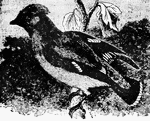
Waxwing
"The Waxwing is an insessorial bird belonging to the dentirostral section of the order. It derives its…

Waxwing
A class of birds native to the United States and Europe, and so named from the secondary wing feathers…
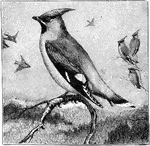
One Waxwing Sitting on a Branch in the Forefront with Three Waxwings Sitting on Branches and Four Flying Around in the Background
"Both sexes of our irregular winter-visitor the Waxwing (Ampelis garrulus) are silky greyish-brown,…
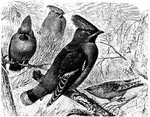
Bohemian Waxwing
"Ampelis garrulus. Bohemian Waxwing. General color brownish-ash, shading insensibly from the clear ash…
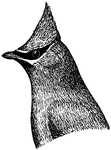
Cedar Waxwing
The Cedar Waxwing (Bombycilla cedrorum) is a member of the family Bombycillidae or waxwing family of…
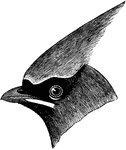
Cedar Waxwing
"Ampelis cedrorum. Cedar Waxwing. Carolina Waxwing. Cedar-bird. Cherry Bird. General color shading from…
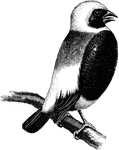
Weaver-bird
"Pyromelaena flammiceps, the Weaver-birds, the coloration of these rather small birds is most striking,…
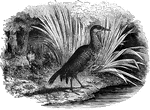
Weka
"Seventeen inches long; color brown; it flies badly, but runs with great swiftness; never takes to the…
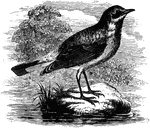
Wheatear
Wheatear male has a bluish-gray back, black patch on ear, a white rump and sides of tail, and black…
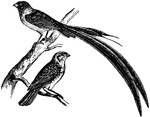
Whidah-Birds
"The Whidah-Birds have long, drooping tail feathers. They are natives of South Africa and Senegal."
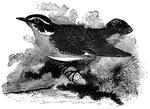
Whinchat
The whinchat is a migratory European bird, which subsists on a diet of worms, insects, small shell-mollusks,…
![The Whip-poor-will or whippoorwill, Caprimulgus vociferus, is a medium-sized (22-27 cm) nightjar from North and Central America. The Whip-poor-will is commonly heard within its range, but less often seen. It is named onomatopoeically after its call. This bird is sometimes confused[1] with the related Chuck-will's-widow (Caprimulgus carolinensis) which has a similar but lower-pitched and slower call. Adults have mottled plumage: the upperparts are grey, black and brown; the lower parts are grey and black. They have a very short bill and a black throat. Males have a white patch below the throat and white tips on the outer tail feathers; in the female, these parts are light brown.](https://etc.usf.edu/clipart/57000/57013/57013_whippoorwill_mth.gif)
Whip-poor-will
The Whip-poor-will or whippoorwill, Caprimulgus vociferus, is a medium-sized (22-27 cm) nightjar from…
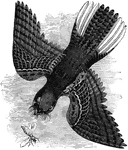
Whippoorwill
A whippoorwill chasing a winged insect. This bird derives its namesake from its distinctive call.
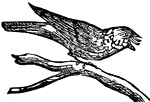
Whippoorwill
An American bird, allied to the nighthawk and nightjar, so called from its note, or the sounds of its…
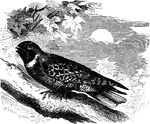
Large Whippoorwill
"Antrostomus vociferus. Whippoorwill. Night-jar. Upper parts variegated with gray, black, whitish, and…

Small Whippoorwill
"Antrostomus vociferus. Whippoorwill. Night-jar. Upper parts variegated with gray, black, whitish, and…
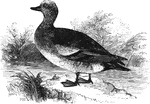
American Widgeon
The American widgeon (or baldpate) averages about nineteen inches in length. It is common in North America,…

Widowbird
The widowbird, also known as the whidahfinch. Although most specimens are about the size of a canary,…
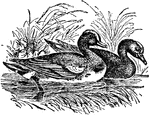
Wigeon
"Wigeon is one of the most popular birds with the American sportsman. Length about eighteen inches;…
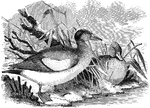
American Wigeon
"Mareca americana. American Wigeon. Bald-pate. Bill grayish-blue, with black tip and extreme base; feet…

Willet Head
"Symphemia semipalmata. Semipalmated Tattler. Willet. Adult in summer: Upper parts ashy, confoundedly…
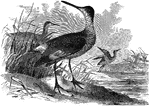
Willets
"Symphemia semipalmata. Semipalmated Tattler. Willet. Adult in summer: Upper parts ashy, confoundedly…

Western Wood Pewee
The Western Wood-Pewee, Contopus sordidulus, is a small tyrant flycatcher. Adults are gray-olive on…
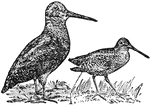
Woodcock
The name of several birds commonly classed in the same genus as the snipes, but having a more bulky…

Woodcock
"Scolopas rusticula, the well known Woodcock, brown, grey, and buff in color, with blackish vermiculations…

American Woodcock Head
"Philohela. American Woodcock. First three primaries emarginate, attenuate and falcate, abruptly shorter…
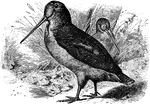
American Woodcock
"Philohela minor. Woodcock. Bog-sucker. Colors above harmoniously blended and varied black, brown, gray,…
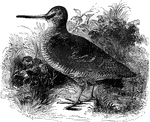
European Woodcock
The European woodcock averages about thirteen inches in length, and prefers to feed on earthworms. It…
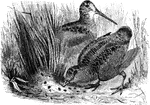
Probing American Woodcock
"Philohela minor. Woodcock. Bog-sucker. Colors above harmoniously blended and varied black, brown, gray,…
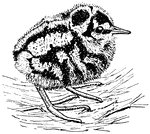
Young Woodcock
The woodcocks are a group of seven extant very similar wading bird species in the genus Scolopax, characterised…

Woodcocks (White and Isabelle-colored)
"They are shy, timid birds, concealing themselves by day in the depths of the mots retired woods."

Woodpecker
While a woodpecker is drilling, the two parts of the bill are closed together, making a wedge-pointed…
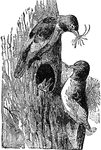
Woodpecker
A genus of birds belonging to the climbers, and so called from their habit of pecking into trees in…
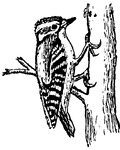
Woodpecker
The woodpeckers, piculets and wrynecks are a family, Picidae, of near-passerine birds . Members of this…
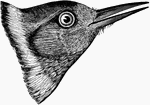
Lewis' Woodpecker Head
"Asyndesmus torquatus. Lewis' Woodpecker. Lared Woodpecker. Adult: Upper parts, including wings and…
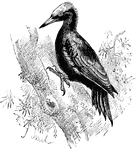
Great Black Woodpecker
Great Black Woodpecker (Drycopus martius). This bird of one of the largest of its tribe, black with…
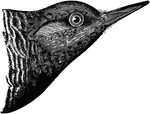
Brown-headed Woodpecker
"Sphyropicus thyroides. Brown-headed Woodpecker. Black-breasted Woodpecker. Red-throated Woodpecker.…
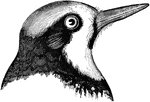
Californian Woodpecker
"Melanerpes formicivorus bairdi. Californian Woodpecker. Glossy blue-black; rump, bases of all the quills,…

Downy Woodpecker
The woodpeckers are typical climbers, with two toes turned forward and two backward, (zygodactyl).
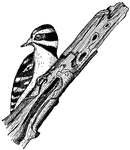
Downy Woodpecker
The Downy Woodpecker, Picoides pubescens, is the smallest woodpecker in North America. Adults are mainly…

Downy Woodpecker
"Picus pubescens. Downy Woodpecker. Usually 6-7 long; outer tail-feathers barred with black and white.…
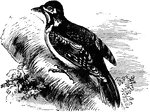
European Spotted Woodpecker
"Picus major. European Spotted Woodpecker. Bill more or less nearly equal to head in length, stout,…
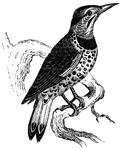
Golden-Winged Woodpecker
The golden-winged woodpecker is known for burrowing its own holes into live trees to use as a nest.
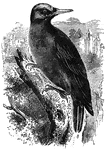
Great black Woodpecker
Chiefly making its habitat in Northern Europe, the great black woodpecker uses its long, sharp bill…
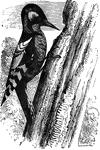
Great Spotted Woodpecker
The great spotted woodpecker measures an average of nine and a half inches long, and is found throughout…
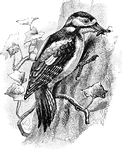
Great Spotted Woodpecker
A loud bird that uses it beak to bore holes in tree trunks to feed on bugs.
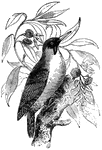
Green Woodpecker
The green woodpecker is found throughout Europe, and uses its beak to make holes in tree trunks to roost…
